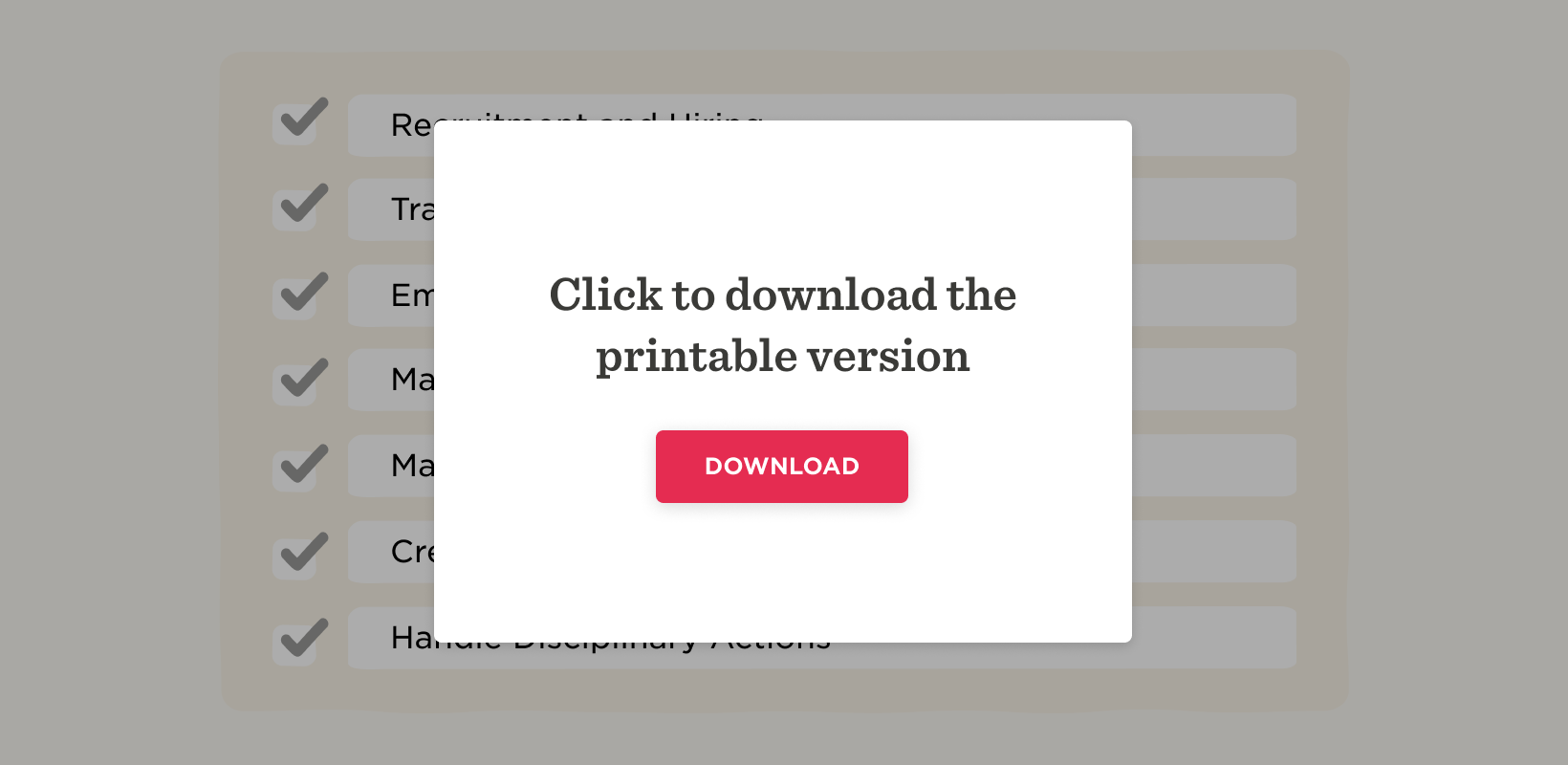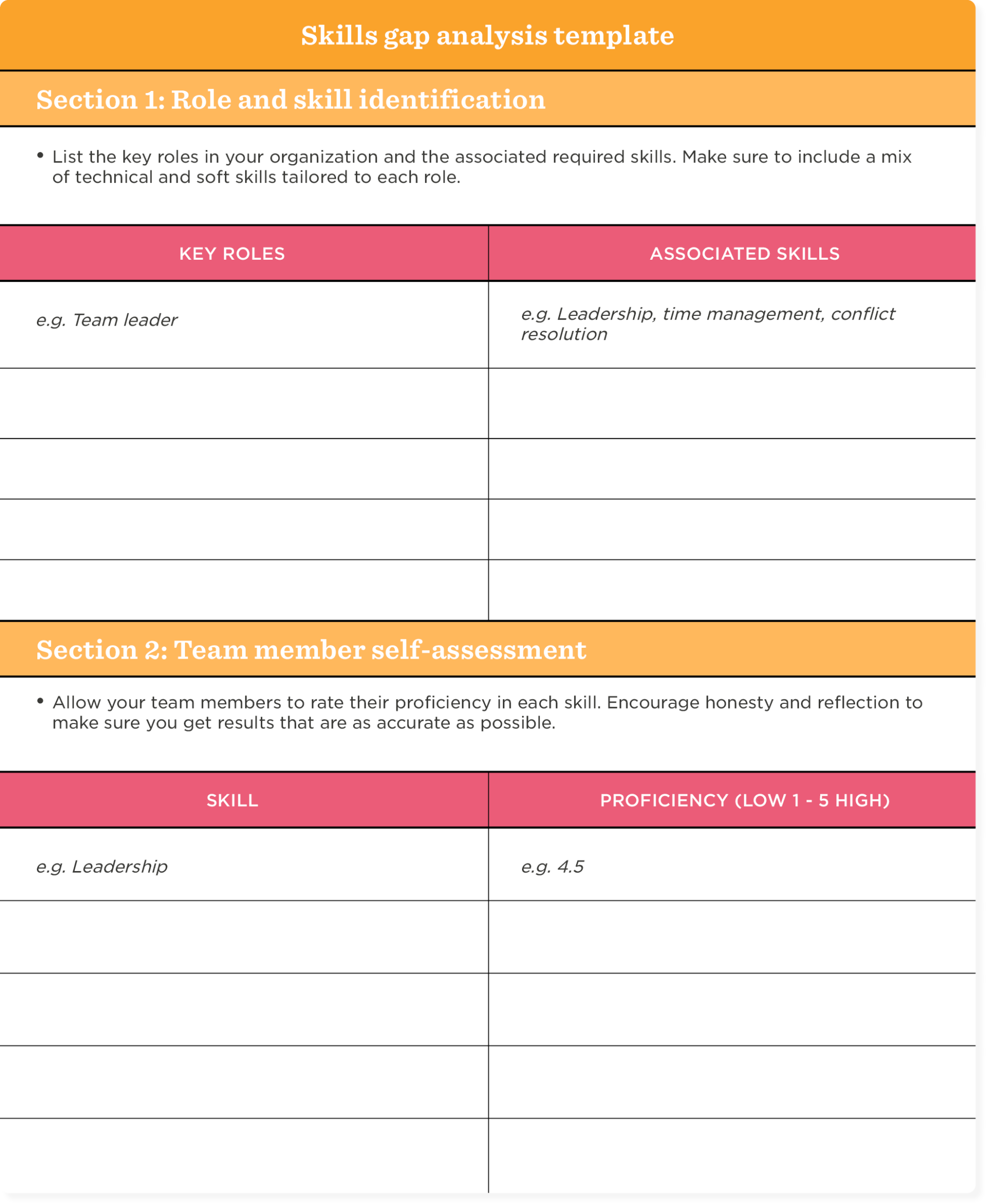In times of economic and socio-political strain, the ability to adapt, grow, and stay ahead of the curve is key for organizations wanting to remain competitive. A major part of being able to do this lies in making sure your team’s skills align with your organization’s needs.
But as the world changes, so do business goals. And as business goals change, the skills needed to stay competitive change with them.
This is why HR and recruitment teams are always looking out for the best and brightest talent to recruit and drive the organization forward to success, both now and in the future.
With the ebbs and flows of the modern business world, organizations can perform best when they keep up to date with their team’s current skill sets and how these correlate with the needs and goals of the business.
That’s where a skills gap analysis template is useful.
Read on as we dive into the skills gap analysis process and provide you with a comprehensive template to focus and streamline this crucial task.

What is a skills gap analysis?
An organization can use a skills gap analysis to assess whether or not the skills of their current team meet the organization’s goals and needs.
It’s a process usually carried out by HR and/or L&D teams as they are best placed to understand the skills your team members already have, where improvements are needed, and what skills need to be further developed.
This analysis isn’t just about identifying potential areas for improvement. It’s also about recognizing the strengths your team already has and utilizing these skills to their full potential.
The importance of conducting a skills gap analysis
In the business world, the only real constant is change. And in an environment where things can drastically change almost daily, carrying out a skills gap analysis isn’t just recommended, it’s vital.
The importance of this analysis impacts different parts of your organization and can improve efficiency in a number of ways. This includes:
- Boosting engagement and retention. When people get regular opportunities to level up their skills and boost their career growth, they are far more likely to feel valued and engaged. This not only boosts their productivity but also increases their loyalty to an organization that clearly values their development and potential.
- Improving recruitment and training strategies. Understanding the specific skill sets of your team members allows you to tailor your recruitment and training strategies to find and train people to help fill any gaps, or fix them through employee learning and development.
- Enhancing your competitive advantage. Conducting a thorough HR gap analysis and learning where your areas for improvement are can give you a serious boost over your competitors. Having a team of people who are adaptable, skilled, and ready to meet challenges head-on means your organization will be in a position to thrive both now and in the future.
- Keeping teams and organizations aligned. As your organization grows and evolves, it’s important to make sure that your team is also growing and evolving. Conducting a skills gap analysis ensures your people’s abilities fully align with your organizational needs.
- Strengthening your bottom line. By spotting and addressing skills gaps within your team, you can improve your overall organization. This includes streamlining your processes, boosting productivity, and cutting down on inefficiencies. Aside from leading to a more balanced and capable team, this also helps to improve your financial performance as your team members become more effective in their roles. You can reduce operational costs, increase output, and potentially increase revenue.
<<Download and print this template to conduct an effective skills gap analysis.>>
How to conduct a successful skills gap analysis
Conducting a skills gap analysis is a process that involves several steps in order to get a full understanding of your team’s capabilities and needs.
The steps for conducting an effective and successful skills gap analysis are:
Step 1: Define roles and skills
The first step in the process is to identify the key roles within your organization and lay out the specific skills required for each of these roles. Of course, this can vary from organization to organization, especially across different industries.
It’s important to consider both technical skills and soft skills. For example, technical skills might include how proficient someone is in certain software or technology, while soft skills might include leadership abilities, problem-solving, and the ability to communicate effectively.
Step 2: Assess the current skill sets
Once you have the key roles and skills defined, the next step is to assess the current skill levels of your people. Ways to do this include:
- Self-assessments. Allow your people to give an honest evaluation of their own skills. This method has a number of advantages such as gaining insight into your people’s self-perceived strengths and weaknesses, as well as encouraging your people to take time to reflect on their own performance.
- Management assessments. Management and leaders can evaluate team members’ skills based on their work performance as well as their daily interactions with others.
Step 3: Analyze data and spot gaps
Now that you have data, the next step is to analyze it and try to spot patterns or areas where there may be room for improvement. By analyzing and spotting gaps in your data, you can build an action plan to improve these areas.
Step 4: Develop a strategy to fill gaps
Finally, it’s time to build your strategy that aims to fill these skills gaps. This can include:
- Training and employee development programs. Either design or source specific training programs that can target and close your identified skills gaps. These programs may include online courses, in-house training sessions, workshops, or even formal education programs.
- Mentorship and coaching. Another route to fill skills gaps is to utilize the talent you already have. By pairing your less experienced team members with mentors, you can effectively transfer knowledge and skills. This is also a great way to build an internal culture of knowledge sharing.
- Recruitment. If you can’t fill your skills gaps through internal resources, the next step is to start looking for external talent that has the skills you’re looking for.
Your skills gap analysis template
We’ve created an employee skills gap analysis template as a helpful tool, designed to give you a starting point for this process. You can either use this as-is or adapt it to your organization and industry.
We designed this free skills gap analysis template to be simple, easy to complete, and flexible so that you can adapt it across a wide range of industries and organization sizes.
<<Download and print this template to conduct an effective skills gap analysis.>>
Bridging the gap: Developing a strategic action plan
Having a solid L&D strategy is a great way to help bridge skills gaps. Effective strategies are:
- Aligned with your organizational goals. Make sure your training and employee development plans are closely aligned with your organization’s strategic objectives.
- People-focused. Tailor the learning experiences to meet the individual needs and learning styles of your team.
- Outcome-focused. For each objective, set clear, measurable goals. This helps to provide clear direction and allows you to evaluate the effectiveness of the program.
- Continuous and adaptive. The learning and development process should be ongoing, helping your people to continually grow and evolve alongside your organization.
Recommended For Further Reading
Implementing your action plan
Putting your plan into action is just as important as designing and developing it. To do so, it’s important to focus on:
- Effective communication. Clearly communicate exactly what you want this plan to achieve and how it will help your team and your organization as a whole.
- Resource allocation. When a plan has everything it needs to succeed, it has the potential to make real change within your organization. Make sure you have adequate time, budget, and materials to ensure your plan is a success.
- Monitoring progress. Keep a close eye on the progress of your action plan, whether that’s the progress in your training initiatives or ensuring that your people are truly benefitting from what you’ve put in place.
- Feedback and adjustments. Put a system in place that allows you to receive regular feedback. With this regular critique, you can get a clearer view of the effectiveness of your plan and make adjustments where necessary.
Help your organization and people reach their potential
Carrying out a skills gap analysis isn’t just a one-time project—it’s an ongoing process that consistently evaluates what you need as an organization to truly push you forward in the ever-competitive world of business.
Not only is a skills gap analysis a strategic business tool, it’s also an effective way to create balanced, harmonious teams that complement each other with a diverse range of skills. By carrying out a skills gap analysis, you can find ways to improve each individual within your organization, helping them to develop their careers and reach their full potential.
Download our free skills gap analysis template today to ensure your team performs to their full potential.
<<Download and print this template to conduct an effective skills gap analysis.>>



